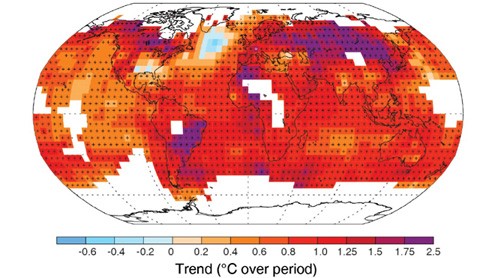The Intergovernmental Panel on Climate Change released its Fifth Assessment Report this past Friday.
A panel of UA scientists convened that day to discuss the findings and how the Southwest is affected by them.
“We’re in the bullseye of climate change,” said Julia Cole, a professor in the Department of Geosciences. “Climate change is happening right here and right now.”
Nearly 1,000 scientists from almost 40 different countries contributed to the IPCC’s report as authors, reviewers and/or editors. The report is based on more than 2 million gigabytes of information, making it arguably the most authoritative reference on climate change for policymakers.
The IPCC stated that “it is extremely likely that human influence on climate caused more than half of the world’s increased temperature from 1951 to 2010.”
This has caused drastic changes across the planet.
According to the report, the “warming of the climate system is unequivocal and, since the 1950s, many of the observed changes are unprecedented over decades to millennia.”
The temperatures for both the atmosphere and oceans have increased, the sea level has risen and greenhouse gases are present in higher concentrations.
Cole clarified that with the effects of climate change, the dry lands will get drier and the wet lands will get wetter.
“The warmer we make the world, the stronger the patterns we are going to see,” she said.
This means that, with each degree the temperature rises, the impact on plant life, atmosphere, and precipitation will increase at an accelerating rate.
Joellen Russell, an associate professor in the Department of Geosciences, spoke about the IPCC’s findings that the oceans’ acidity and levels are changing. The ocean is heating up, she said. It stores about 93 percent of the heat in the earth’s atmosphere, and it’s getting warmer.
Right now, we’re seeing a bit of a slow in rising temperatures, Russell said, but that’s only because the deep ocean is taking it in. The heat’s not going away; it’s just being absorbed in larger amounts.
Michael Crimmins, an associate professor in the Department of Soil, Water and Environmental Science, covered the change in temperature records. He said that Arizona has had the strongest temperature trend in the lower 48 states, which researchers previously agreed on but is now confirmed by the IPCC.
Russell Monson, a Louise Foucar Marshall professor in the School of Natural Resources and Environment, spoke about the findings concerning greenhouse gases.
Carbon dioxide is a big concern right now, with levels reaching 400 parts per million, the highest in the last 800,000 years, a time period that basically covers the entirety of human existence, Monson said.
With higher temperatures and increasing water scarcity, the forests and various other plant life are under greater and greater stress to convert that carbon dioxide into oxygen.
Cole finished the panel by showing how the research applies to the Southwest.
“It’s going to get drier, that much we know for sure,” Cole said. There will likely be less summer rain and a shorter monsoon season. Vegetation will shift, with water scarcity and higher temperatures pushing them uphill, and animal life will probably follow.
However, Cole said she’s optimistic about the future and believes change is a real possibility.
“It is encouraging to see climate change being picked up as a real risk-management issue outside the scientific community,” Cole said.









